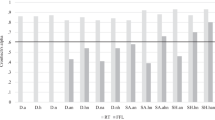Abstract
College students (12 female, 12 male) were assigned to either higher caffeine user (HCU) or lower caffeine user (LCU) groups based on a caffeine usage survey. Prior to testing, subjects ingested either placebo or 195 or 325 mg caffeine. They then performed a visual vigilance task measuring response blocks, discrete response (hits and false alarms), reaction times, and a Mood Check List using a double-blind design. HCU made significantly fewer hits, more false alarms, and also responded faster than LCU. No significant main effects of caffeine administration were found. In the mood analyses, male subjects were more anxious at the end of the experiment. Overall, the user factor (HCU versus LCU) was the most potent experimental variable.
Similar content being viewed by others
References
Bachrach H (1966) Note on psychological effects of caffeine. Psychol Rep 18:86
Baker WJ, Theologus GC (1972) Effects of caffeine on visual monitoring. J Appl Psychol 56:422–427
Barmack JE (1940) The time of administration and some effects of 2 g alkaloid caffeine. J Exp Psychol 27:690–698
Cattell RB (1930) The effects of alcohol and caffeine on intelligent and associative performance. Br J Medical Psychol 10:20–33
Cheney RH (1935) Comparative effect of caffeine per se and a caffeine beverage (coffee) upon the reaction time in normal young adults. J Pharmacol Exp Ther 53:304–313
Cheney RH (1936) Reaction time behavior after caffeine and coffee consumption. J Exp Psychol 19:357–369
Childs JM (1978) Caffeine consumption and target scanning performance. Hum Factors 20:91–96
Costill DL, Dalsky GP, Fink WJ (1978) Effects of caffeine ingestion on metabolism and exercise performance. J Med Sci Sports 10:155–158
Franks HM, Hagedorn H, Hensley VR, Stramer GA (1975) The effect of caffeine on human performance, alone and in combination with ethanol. Psychopharmacologia 45:177–181
Gough HG, Heilbrun AB Jr (1965) The adjective check list manual. Consulting Psychologist Press, Palo Alto CA
Hauty GT, Payne RB (1955) Mitigation of work decrement. J Exp Psychol 49:60–67
Hayes WL (1963) Statistics for psychologists. Holt Rinehart Winston, New York
Holland JG (1968) Human vigilance. Science 128:61–67
Hollingworth HL (1912) The influence of caffeine on mental and motor efficiency. Arch Psychol (NY) 3:1–166
Landgrebe B (1960) Vergleichende Untersuchungen mit dem Flimmertest nach coffeinhaltigem und coffeinfreiem Kaffee. Med Welt 2:1486–1490
Long JW (1982) The essential guide to prescription drugs. Harper and Row, New York
Modell W (ed) (1978) Drugs in current use and new drugs. Springer, Berlin Heidelberg New York
Rall TW (1980) Central nervous system stimulants: The xanthines. In: Goodman LS, Gilman A (eds) The pharmacological basis of therapeutics. Macmillan, New York, pp 592–607
Regina EG, Smith GM, Keiper CG, McKelvey RK (1974) Effects of caffeine on alertness in simulated driving. J Appl Psychol 59:483–489
Seashore RH, Ivy AC (1953) The effects of analeptics in relieving fatigue. Psychol Monogr (Gen Appl) 67:1–13
Thackray RI, Touchstone RM, Bailey JP (1978) Comparison of the vigilance performance of men and women using a simulated radar task. Aviat Space Environ Med 49:1215–1218
Waag WL, Halcomb CG, Tyler DM (1973) Sex differences in monitoring performance. J Appl Psychol 58:272–274
Weiss B, Laties VG (1962) Enhancement of performance by caffeine and the amphetamines. Pharmacol Rev 14:1–36
White BC, Lincoln CA, Pearce NW, Reeb R, Vaida C (1980) Anxiety and muscle tension as consequences of caffeine withdrawal. Science 209:1547–1548
Winer BJ (1971) Statistical principles in experimental design. McGraw Hill, New York
Author information
Authors and Affiliations
Rights and permissions
About this article
Cite this article
Loke, W.H., Meliska, C.J. Effects of caffeine use and ingestion on a protracted visual vigilance task. Psychopharmacology 84, 54–57 (1984). https://doi.org/10.1007/BF00432024
Received:
Accepted:
Issue Date:
DOI: https://doi.org/10.1007/BF00432024




